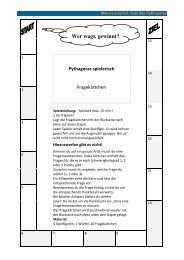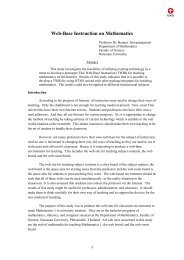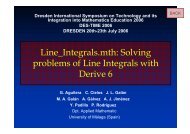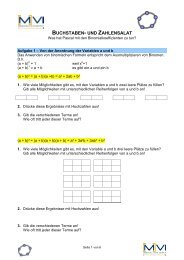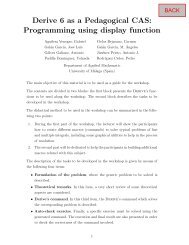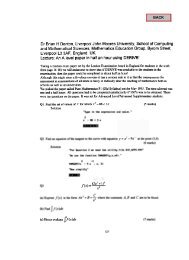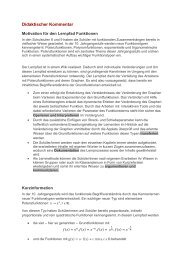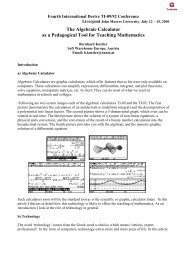Discovering and proving geometric inequalities by CAS (pdf)
Discovering and proving geometric inequalities by CAS (pdf)
Discovering and proving geometric inequalities by CAS (pdf)
Create successful ePaper yourself
Turn your PDF publications into a flip-book with our unique Google optimized e-Paper software.
<strong>and</strong> y − v =0, i.e., that A − D = B − C.<br />
Formal verification<br />
Use R::=Q[xyuvabcdef];<br />
I:=Ideal((x-a)^2+y^2-b^2,(x-u)^2+(y-v)^2-c^2,u^2+v^2-d^2,x^2<br />
+y^2-e^2,(u-a)^2+v^2-f^2,a^2+b^2+c^2+d^2-e^2-f^2);<br />
NF((x-u-a)^2+(y-v)^2,I);<br />
confirms that normal form equals 0 <strong>and</strong> a quadrilateral which fulfils a 2 +b 2 +c 2 +d 2 = e 2 +f 2<br />
is a parallelogram. The statement is true.<br />
Remark:<br />
If we would enter x − u − a =0<strong>and</strong>y − v =0, instead of the ”equivalent” condition<br />
(x − u − a) 2 +(y − v) 2 =0, which also characterizes a parallelogram, we have failed. We<br />
get<br />
Use R ::= Q[xyuvabcdefts];<br />
I:=Ideal((x-a)^2+y^2-b^2,(x-u)^2+(y-v)^2-c^2,u^2+v^2-d^2,<br />
x^2+y^2-e^2,(u-a)^2+v^2-f^2,a^2+b^2+c^2+d^2-e^2-f^2,(x-u-a)t-1);<br />
NF(1,I);<br />
the result 1.<br />
What is the difference between the conditions<br />
(x − u − a) 2 +(y − v) 2 =0 <strong>and</strong> x − u − a =0∧ y − v =0?<br />
’The only difference‘ consists in the fact that whereas in a real case both conditions are<br />
the same, in the case of complex numbers is (x − u − a) 2 +(y − v) 2 =(x − u − a +<br />
i(y − v))(x − u − a − i(y − v)), i.e., we get two conditions x − u − a + i(y − v) =0 ∨<br />
x − u − a − i(y − v) =0!<br />
This example should be instructive.<br />
We have always to consider such conditions which the system requires (<strong>and</strong> mostly yields).<br />
Any ”changes” of these conditions, despite they describe the reality properly, mostly lead<br />
to the failure.<br />
Solving <strong>inequalities</strong><br />
We will study some <strong>geometric</strong> <strong>inequalities</strong> discovered <strong>and</strong> proved <strong>by</strong> means of Buchberger’s<br />
algorithm for computing Groebner bases of ideals. However we should realize that we are<br />
working in an algebraic closed field, in our case in the field of complex numbers which, as<br />
known, can not be ordered. Hence we can not use the signs > or





